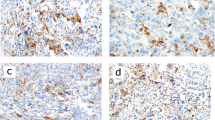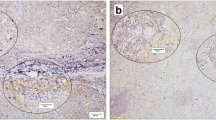Abstract
The aim of this study was to evaluate the prognostic value of light chain 3 (LC3) expression in triple-negative breast cancer (TNBC) and describe the association of LC3 expression with the occurrence of metastasis. LC3 expression in tissue microarray was evaluated by immunohistochemistry in 163 patients with TNBC. The prognostic value of LC3 expression was assessed by a Cox regression model adjusted for clinical characteristics. Low LC3 expression in TNBC was observed in 56 (34.4 %) of 163 TNBC. Low LC3 expression significantly correlated with a higher risk of distant metastasis, rather than locoregional relapse. The 10-year distant metastases-free survival for LC3-negative and LC3-positive patients was 57.2 and 95.1 %, respectively (p < 0.0001). Accordingly, a significant correlation was found between LC3 expression and disease-free survival (DFS) and overall survival (OS). Multivariate analysis indicated that LC3 negative was a significant independent prognostic factor of DFS (p = 0.019), but not for OS (p = 0.545) in all patients. Our results suggested that expression of LC3 in TNBC was associated with higher distant metastases. This finding could open new avenues for the development of novel therapy strategies to TNBC.


Similar content being viewed by others
References
Dent R, et al. Triple-negative breast cancer: clinical features and patterns of recurrence. Clin Cancer Res. 2007;13:4429–34.
Carey LA, et al. The triple negative paradox: primary tumor chemosensitivity of breast cancer subtypes. Clin Cancer Res. 2007;13(8):2329–34.
Tischkowitz M, et al. Use of immunohistochemical markers can refine prognosis in triple negative breast cancer. BMC Cancer. 2007;7:134.
Bauer KR, et al. Descriptive analysis of estrogen receptor (ER)-negative, progesterone receptor (PR)-negative, and HER2-negative invasive breast cancer, the so-called triple-negative phenotype: a population-based study from the California cancer Registry. Cancer. 2007;109(9):1721–8.
Scherz-Shouval R, et al. p53-dependent regulation of autophagy protein LC3 supports cancer cell survival under prolonged starvation. Proc Natl Acad Sci USA. 2010;107:18511–6.
Cheong H, et al. Biochemical methods to monitor autophagy-related processes in yeast. Met Enzymol. 2008;451:1–26.
Eskelinen EL, et al. Autophagy: a lysosomal degradation pathway with a central role in health and disease. Biochim Biophys Acta. 2009;1793(4):664–73.
Klionsky DJ, et al. Guidelines for the use and interpretation of assays for monitoring autophagy in higher eukaryotes. Autophagy. 2008;4(2):151–75.
Kuma A, et al. LC3, an autophagosome marker, can be incorporated into protein aggregates independent of autophagy: caution in the interpretation of LC3 localization. Autophagy. 2007;3(4):323–8.
Furuya D, et al. Beclin 1 augmented cis-diamminedichloroplatinum induced apoptosis via enhancing caspase-9 activity. Exp Cell Res. 2005;307(1):26–40.
Ahn CH, et al. Expression of beclin-1, an autophagy-related protein, in gastric and colorectal cancers. APMIS. 2007;115(12):1344–9.
Kondo Y, et al. The role of autophagy in cancer development and response to therapy. Nature reviews. Cancer. 2005;5(9):726–34.
Liang XH, et al. Beclin 1 contains a leucine-rich nuclear export signal that is required for its autophagy and tumor suppressor function. Cancer Res. 2001;61:3443–9.
Sivridis E, et al. LC3A-positive light microscopy detected patterns of autophagy and prognosis in operable breast carcinomas. Am J Pathol. 2010;176(5):2477–89.
He J, et al. Prognostic value of androgen receptor expression in operable triple-negative breast cancer: a retrospective analysis based on a tissue microarray. Med Oncol. 2012;29(2):406–10.
Reggiori F, et al. Autophagy in the eukaryotic cell. Eukaryot Cell. 2002;1(1):11–21.
Shintani T, et al. Autophagy in health and disease: a double-edged sword. Science. 2004;306:990–5.
Klionsky DJ, et al. Autophagy as a regulated pathway of cellular degradation. Science. 2000;290:1717–21.
Giatromanolaki A, et al. Tumour angiogenesis: vascular growth and survival. APMIS. 2004;112(7–8):431–40.
Martinet W, et al. Detection of autophagy in tissue by standard immunohistochemistry: possibilities and limitations. Autophagy. 2006;2:55–7.
Fulford LG, et al. Specific morphological features predictive for the basal phenotype in grade 3 invasive ductal carcinoma of breast. Histopathology. 2006;49(1):22–34.
Livasy CA, et al. Phenotypic evaluation of the basal-like subtype of invasive breast carcinoma. Mod Pathol. 2006;19(2):264–71.
Kabeya Y, et al. LC3, a mammalian homologue of yeast Apg8p, is localized in autophagosome membranes after processing. EMBO J. 2000;19(21):5720–8.
He H, et al. Post-translational modifications of three members of the human MAP1LC3 family and detection of a novel type of modification for MAP1LC3B. J Bio Chem. 2003;278(31):29278–87.
Sato K, et al. Autophagy is activated in colorectal cancer cells and contributes to the tolerance to nutrient deprivation. Cancer Res. 2007;67(20):9677–84.
Berardi DE, et al. Autophagy: friend or foe in breast cancer development, progression, and treatment. Int J Breast Cancer. 2011;59:509–12.
Shen Y, et al. Decreased expression of autophagy-related proteins in malignant epithelial ovarian cancer. Autophagy. 2008;4:1067–8.
Jiang ZF, et al. Decreased expression of Beclin-1 and LC3 in human lung cancer. Mol Biol Rep. 2012;39:259–67.
Marino G, et al. Tissue-specific autophagy alterations and increased tumorigenesis in mice deficient in Atg4C/autophagin-3. J Biol Chem. 2007;282(25):18573–83.
Fujii S, et al. Autophagy is activated in pancreatic cancer cells and correlates with poor patient outcome. Cancer Sci. 2008;99:1813–9.
Zhu W, et al. Expression of Beclin 1 and LC3 in FIGO stage I-II cervical squamous cell carcinoma and relationship to survival. Tumour Biol. 2012;33:1653–9.
Liang XH, et al. Induction of autophagy and inhibition of tumorigenesis by beclin 1. Nature. 1999;402:672–6.
Acknowledgments
This study was financially supported by the Science and Technology Program of Guangdong Province (No. 2009B030801114). The funders had no role in study design, data collection and analysis, decision to publish, or preparation of the manuscript.
Conflict of interest
None.
Author information
Authors and Affiliations
Corresponding author
Additional information
Rong-Zhen Luo contributed equally to this work.
Rights and permissions
About this article
Cite this article
He, JH., Luo, RZ., Cai, MY. et al. Decreased expression of light chain 3 (LC3) increased the risk of distant metastasis in triple-negative breast cancer. Med Oncol 30, 468 (2013). https://doi.org/10.1007/s12032-013-0468-0
Received:
Accepted:
Published:
DOI: https://doi.org/10.1007/s12032-013-0468-0




